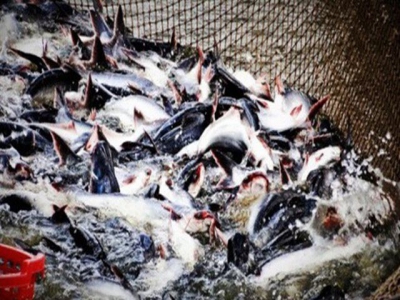Catfish firms seek to exploit domestic market

Meeting barriers in foreign markets, catfish processing companies have decided to exploit the domestic market.
At the year-end seafood trade fair, visitors had a nice surprise as they could enjoy 90 dishes made from catfish by famous chefs – Quoc Vo and Chiem Thanh Long.
The performance at the trade fair was part of Co May Company’s strategy to introduce catfish to the domestic market.
“We are creating a variety of products from catfish to bring fish to the dining table of Vietnamese people,” said Pham Minh Thien, general director of Co May.
Catfish farmers and exporters experienced a tough 2019 year as the export markets were gloomy and the catfish prices fell sharply. By the end of November 2019, Vietnam’s catfish still could not escape the minus growth rate compared with the same period of 2018.
Catfish farmers and exporters experienced a tough 2019 year as the export markets were gloomy and the catfish prices fell sharply. By the end of November 2019, Vietnam’s catfish still could not escape the minus growth rate compared with the same period of 2018.
According to Thien, this was foreseen two years ago. As the catfish prices escalated, farmers rushed to farm catfish. Some farmers even doubled their farming areas, thus leading to the oversupply.
Farmers cannot sell domestically to mitigate risks as Vietnamese are not familiar with catfish.
It will take seafood companies a lot of time and effort to conquer the home market.
Also trying to exploit the domestic market, Vinh Hoan JSC is trying to make snacks from fish skin. However, though the leading company in the industry, the company also anticipates difficulties.
The company saw revenue decreasing by 13.3 percent and profit by 5.3 percent as of Q3 2019 because of the decrease in both sale volume and selling price.
The demand from the US, an important market for Vietnam, decreased dramatically by 60.2 percent compared with the same period last year.
Vinh Hoan and Bien Dong are the two companies which can export catfish products to the US market with the tariff of zero percent. In order to be able to continue exporting catfish, many companies try to farm fish in accordance with organic standards.
According to the Vietnam Association of Seafood Exporters and Producers (VASEP), many markets have shifted to consume organic catfish fillets, such as the US, Germany and Japan.
Germany, the third largest export market for Vietnam in Europe, has increased imports by 36 percent compared with the same period of 2018 and the import products were frozen organic catfish fillets.
Organic catfish products were sold at the high prices of $9.6-9.78 per kilogram, but they were still chosen by consumers.
Therefore, Bien Dong has set up an organic catfish farming area along Hau River. According to Nguyen Duc Trung from Bien Dong, the company is applying a modern farming process with records about breeder management, water supply, ponds, waste water, feed management and care.
Related news
 Shrimp exports will be positive in 2020
Shrimp exports will be positive in 2020 In 2019, although it has not achieved results as expected, Vietnam’s shrimp exports to major markets have showed positive signs for 2020.
 Trà Vinh farmers harvest mud crab for Tết, earn high profit
Trà Vinh farmers harvest mud crab for Tết, earn high profit Farmers in Trà Vinh Province are entering the mud crab harvest for Tết (Lunar New Year) and earning a high profit of VNĐ30 - 35 million (US$1,300 - 1,500)
 Vietnam aims for 9 bln USD worth of fishery exports in 2020
Vietnam aims for 9 bln USD worth of fishery exports in 2020 Vietnam has targeted to earn $9 billion from fishery exports in 2020, a year-on-year increase of 7 percent, according to the Directorate of Fisheries.